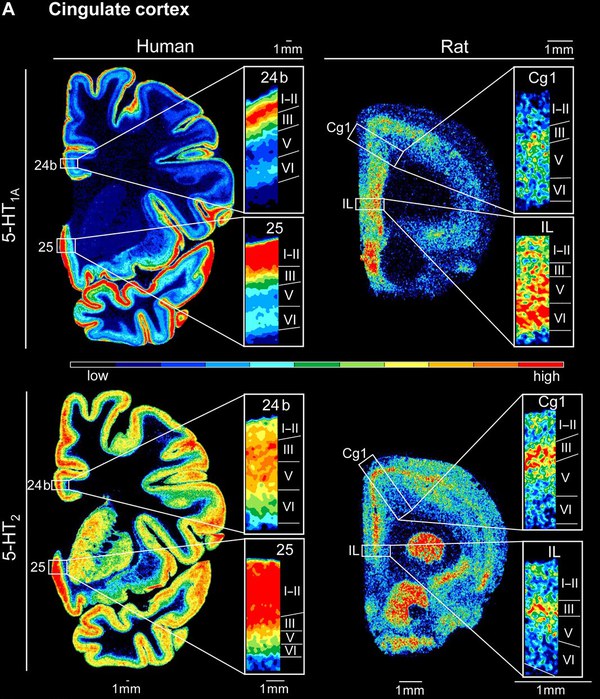Serotonin receptors: Differences in the brains of humans and rats
The neurotransmitter serotonin, also known as the “happiness hormone,” plays a crucial role in the brain's processing of emotions. In depressive disorders, serotonergic signaling is often disrupted. To better understand the development of the disorder and ultimately develop better medications, researchers are investigating serotonin receptors. In a recent study, scientists at the Institute of Neuroscience and Medicine (INM-1) compared the distribution of certain serotonin receptors in the brains of humans and rats and discovered significant differences. The study has now been published in the Journal of Comparative Neurology.
The team of researchers investigated the distribution of two important serotonin receptors, 5-HT1A and 5-HT2, in different areas and layers of the brain, including the cerebral cortex, the hippocampus, and the nucleus accumbens. To do this, they used in vitro receptor autoradiography, which allows a large number of different receptor molecules to be determined quantitatively and region-specifically in tissue sections of the brain.

Key findings of the study: There are significant differences between humans and rats in terms of both the distribution and quantity of these receptors in the brain. For example, humans showed a different distribution of receptors in the hippocampus and cerebral cortex. The ratio between the different receptor types also varied. The scientists see the results of the study as an important indication that species-specific differences should be taken into account in further research on (impaired) serotonergic signaling.
Original publikation:
Kuckertz, A., Zhao, L., Kedo, O., Amunts, K. and Palomero-Gallagher, N. (2025), Serotonin Receptors in Areas of the Emotion Regulation Network in Human and Rat Brains—A Comparative Autoradiographic Study. J Comp Neurol, 533: e70068. https://doi.org/10.1002/cne.70068
Contact
apl-.Prof. Dr. rer. nat. Nicola Palomero-Gallagher
Working Group Leader "Receptors"
- Institute of Neurosciences and Medicine (INM)
- Structural and Functional Organisation of the Brain (INM-1)
Room 2005b
Press contact
Erhard Zeiss
Wissenschaftlicher Kommunikationsreferent
- Institute of Neurosciences and Medicine (INM)
- Structural and Functional Organisation of the Brain (INM-1)
Room 3033


